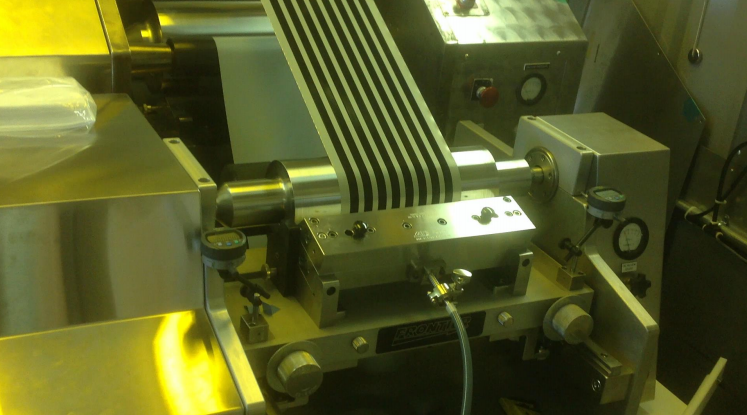
Coating In-house Vs. Outsourcing: 3 Steps to Making a Critical Decision
Dr. Cohen, who sadly passed away in 2021, was considered one of the industry’s foremost experts in all aspects of the web coating experience. After a lengthy career at DuPont, he consulted on coating throughout the converting industry. He will be missed, and we were fortunate to capture his insights in this post.

When we posed the question about whether or not to outsource your coating, Dr. Cohen responded that we weren’t asking the right question. What you really want to ask is “Where should your coating take place?”
Why Ask Where?
There is a beauty in simplicity, without a doubt. But in the world of coating, in which each job produces 3,000 to 4,000 variables, there isn’t a black-and-white answer to coating “in-house vs. outsourcing.”
Dr. Cohen’s point with asking “where” reframes the issue, and essentially customizes it. Because it doesn’t really matter if you’re keeping the process in-house or outsourcing. All that truly matters is that you’re choosing the right coating option at the right time for your product.

And part of factoring in what works best for you today is choosing the option that will give you an idea of how things will look tomorrow. The data you glean from your coating process of choice should yield data that can be used to project a future state: How will this work when you scale up?
Step 1: Start With the Three Coating Options
You have to start somewhere when you’re making a coating decision. Dr. Cohen started us out by focusing on essentially three options for coating:
- Manufacturing Line
- Modular Product Coater
- Contract Coater
Let’s take a look at each area.
1. Manufacturing Line
If you work for a manufacturer, you may have the option of using your existing manufacturing line. “You can go into a plant, run and experiment, and hope it works,” Dr. Cohen explained.
There are restrictions in this scenario. You’re at the mercy of the line’s current production schedule. If it’s full through Monday, then you have to wait until Tuesday. In addition, you can only use the current capabilities of the line.
Using the current manufacturing line is an option only if you have sufficient coating technologies to tackle that task at hand, and/or you are on a shoestring budget and you need to be exceptionally resourceful.
2. Modular Pilot Coater
The Modular Pilot Coater has become the game-changer in the coating industry. These stand-alone units come on two platforms; One containing the coater, the second the outside services, such as heating, ventilation, etc.

The beauty of the modular pilot coater is that you have full control of the systems, and you can customize to meet your needs. “You get the advantage of full-scale production, and the capability of a custom coater,” Dr. Cohen explained.
This is the ideal choice once you’ve established some baseline data, and want to work out some of the kinks before making the big leap to either a contract coater or your own manufacturing line.
3. Contract/Toll Coater
For the company with cash in hand, little time to waste and minimal process knowledge, a contract coater might make the most sense.
Equipped with the proper coating technology and a well-trained staff, the contract coater can have you up and running quickly and without the growing pains of learning how coating equipment works. You have little investment other than paying the service cost.
It can also be an initial source of commercial product for the introductory phase of the scale-up.
If you have a sense of which option would work best for you, now factor in the intangibles of step 2.
Step 2: Factor in the Intangibles
Intangibles are the nuances of each of the first three options. As you dig into intangibles, coating expertise truly comes into play.
There is a ridiculously-wide range of intangibles to consider. We’ve listed three below just to give you food for thought, with Dr. Cohen adding insights as to how they can shape your overall coating decisions.

Remember, you’re thinking about how your product will work as you scale up. You should consider how advanced technologies apply to each intangible to help you envision the future state.
Speed. How fast can your coating process run? Fortunately, the days of coating by hand are done, so you can project high production levels. Companies can use miniaturized roll coaters that can function in a lab setting. “They can go at high enough speeds so you can make some judgements on whether or not to reformulate,” Dr. Cohen said.
Location. The logistics of your coating process is important. As Dr. Cohen pointed out, sometimes the pilot coaters are not in the same location as the product formulators. That proves to be difficult and expensive. You also don’t get the data you need.

Considering the location of your lab coating and pilot scale are important. A lot of information is obtained when formulators and engineers view the actual coating process.
Operators. The equipment operators play a big role in deciding your next step. Dr. Cohen used a slot die startup as an example. Experienced operators tell you if the startup is working correctly and determine if there are any potential operational concern. You can use it’s data to adjust the production accordingly.
We’ve touched on just three of the intangibles to consider — now it’s time to move on to the biggest factor in determining where your coating should take place: You.
Step 3: Analyze Your Own Situation
When you consider your three options and their intangibles, your next step is to conduct a thorough economic analysis of your own company and the product you are trying to produce.
Here are some internal questions that must be answered:
- Do you have the capital for a full coating line (estimated $10 to 20 million)?
- Do you have the capital for modular coaters (estimated $1 to 2 million)?
- What is the cost of formulation?
- What is the yield?
- What is the volume?
- What percentage of time will you use the machine to coat?
- What will you do with the machine when it’s not coating?
- What are the cost of materials?
- How much are you willing to inventory?
- What are shipping costs if you use a contract converter?
- What is the shelf life of the materials?
The list goes on – and it will be nuanced based on your situation. What’s important is to consider your manufacturing process and costs from every angle. The more data you have, the easier it should be to make your ultimate decision.
Where is Coating Heading – and How Does it Fit Into Your Plans?
Putting together an economic analysis of your company’s coating needs is critical. Once your current state is thoroughly assessed, you’ll want to consider developments that are on the horizon.

Dr. Cohen shared some noteworthy trends with us:
- Slot die coating will continue to expand, but all coating methods have improved.
- Cartridge coating will play a big role, allowing operators to quickly change from one coating method to another in 5 minutes. That makes it easier to bring the process in-house.
- Operating training will play an important role as the amount of variables and complexity of process increases.
- Modularity, as illustrated by cartridge coating, will allow you to modify your process and improve efficiency.
It should be noted that these new developments are not applicable in every situation. Dr. Cohen recalled a trip he had made to Israel, where a company was using a 100-year-old method for coating. Despite all the latest and greatest coating advancements, the method was working extremely well.
The Long Road to the Right Decision
When determining where your coating should take place, the long and short of it is…there is no “short” of it. There is only a long process of analyzing production time, material costs, and different technologies.
Naturally, that timeline can be shortened by working with coating experts or companies that specialize in the processes. But they won’t be able to provide step 3 – analyzing your own situation. That falls on you, and it’s the most important part of the process.
It’s a long road to determining the right coating process for your company and your product. But it’s a process that’s also synonymous with long-term success. Shortchange it at your own risk.
Choose the right methodology for your next coating project.
Published on May 31 2016
Last Updated on Aug 07 2024
Categories: Coating, Delta ModTech Blog, Energy and Energy Storage, Slot Die Coating


